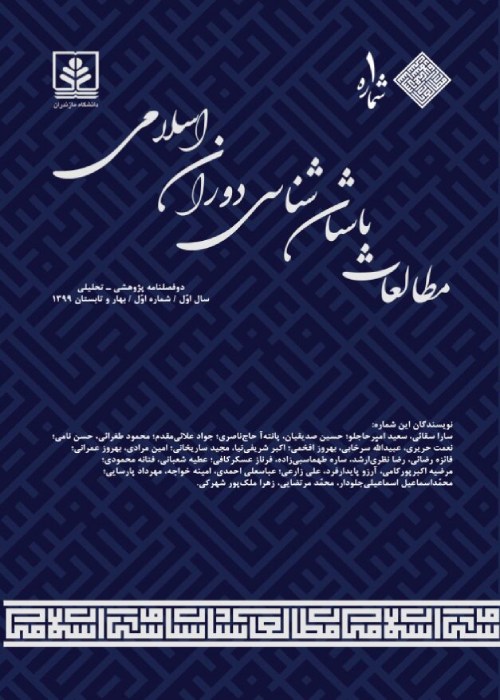Cultural and historical landscape of Narmashir in Kerman during the Islamic era
Historical and Cultural Landscape of Narmashir in Kerman during the Islamic Period IntroductionThe routes of the center of the Iranian plateau to Hormoz, Oman, Sistan, and India passed through Kerman along the Lut desert during the Islamic era. Narmashir plain is located on these routes. The settlements were developed in this plain due to this special location. Furthermore, there are monuments and archaeological evidence in Narmashir from prehistoric to the Islamic period .Therefore, this plain has played an important role in the social and political developments during the Islamic era in southeast Iran, like other urban centers of Kerman.The old city of Narmashir (Choghook Abad site) was one of the five cities of Kerman during the Sassanid and Islamic periods. This old city has 190 hectares, and it was called “Narm-Ardeshir” or “new-Hormoz-Ardeshir” in the Sasanid period. Narmashir was a warehouse for Bam and Oman goods, the center of agriculture and various fruits, the storehouse of Kerman Date, the settlement of wealthy merchant and the midway residence for Sistan pilgrims. But, this cultural landscape is unknown in the archaeological research of Iran. For this reason, introducing the archaeological sites of Narmashir, studying the developments of Islamic settlements in this cultural basin, and analyzing their interactions with neighboring cultural basins has an important role in understanding the cultures of the Islamic period in southeast Iran. Therefore, it is necessary to conduct extensive and methodical research in this cultural basin. The main question is that what are the characteristics of archaeological remains at Narmashir during the Islamic period? And, how is their distribution? The purpose of this article is to introduce, study the monuments, and explain the distribution map of Islamic sites of Narmashir. Materials and MethodsThe archaeological remains of the Islamic period in Narmashir were studied in this article and a map of historical sites in Narmashir was drawn. Data were collected via fieldwork and documentary method. For this, the historical and geographical sources about the cities of Narmashir were studied at the beginning. Then a full coverage survey was conducted, and the remains of the Islamic sites and monuments in the Narmashir plain in an area of 32,000 hectares were recorded and documented. Finally, a map of the distribution of these sites and monuments was prepared, and the factors affecting the formation and development of this cultural landscape were explained. ResultsTwo urban or rural settlements, the old city of Narmashir (Choghok Abad) and Jalal Abad site, as the settlements from early to the late Islamic centuries were identified and studied in the archaeological survey of the cultural landscape of Narmashir plain. Rafi Abad Castle was also identified as a settlement that was used intermittently from the fifth century AH to the Qajar period. Qal’eh Shahid has been the landlord’s house since the late Zand and early Qajar eras. Pirmasha site and Jamali castle are other monuments of the early and middle Islamic period in Narmashir plain. Chehel Tokhm is probably one of the surviving caravanserais in Narmashir plain. Tepe Karton in the western parts of Narmashir cultural landscape is a hill from the Islamic Middle centuries. Furthermore, many towers were identified in this cultural landscape that follow the same pattern and style in construction and decoration. Probably all of these towers were built at the same time. The towers of Zia Abad, Enayat Abad, and Hojjat Abad are among the surviving towers in this plain. Discussion and ConclusionIt seems that two sites of the old city of Narmashir and Jalal Abad were developed between the first to middle Islamic centuries as central settlements in Narmashir plain, based on the study of the distribution map of the monuments and archaeological sites in Narmashir plain. The centrality of the old city of Narmashir and Jalal Abad site is also confirmed based on the comparison, study, and chronology of cultural materials of this two sites. Furthermore, Rafi Abad and Qal’eh Shahid were established as landlord residential centers or periphery settlements. It seems that Rafi Abad in the Middle Islamic centuries was associated with the old city of Narmashir and the Jalal Abad site. Qal’eh Shahid was also established to exploit agricultural lands and garden products in the alluvial plain of Narmashir. Pirmasha site and Jalali castle were considered as military and defense centers. These two buildings played a role in securing the central settlements of the Narmashir plain. The Chehel Tokhm Caravanserai was built to serve the caravans on the routes from the center of the Iranian plateau to Kerman, Bam, Sistan, and the coasts of Oman and India. Tepe Karton was probably considered an industrial site, based on the molded pottery pieces and molds. Furthermore, Zia Abad, Enayat Abad, and Hojjat Abad towers were built to control and maintain security in this plain.The study of the cultural-historical landscape of Narmashir showed that most of these monuments and sites were developed in a linear pattern with an east-west orientation. The formation of this pattern and the east-west axis is probably due to the main road connecting Kerman to Sistan as well as the geographical and climatic features of the Narmashir plain. On the other hand, the construction style and the type of materials in the royal residence of the old city of Narmashir, Shams Castle, Jalal Abad and its Qal’eh Dokhtar show some similarities. Bricks with dimensions of 10 × 38 × 38 cm were used in the main structures in all four buildings. The style and features of beams and flash-like watchtowers are the same in four buildings. The construction method of niches is similar in the buildings of the old city of Narmashir and Jamali Castle. In addition, the choice of location of the buildings indicates similar decisions. Because the Pirmasha site, Jalal Abad, and Jamali castle were built on top of natural sedimentary hills. Impermeable walls were created around these hills due to alluvium. This feature has ensured the security of these settlements. FundingThis research was supported by the administration of cultural heritage in Kerman under grant number 932/137/2736 in 2014, to compile the monuments and sites file for registration in the list of national monuments and sites. Author’s contributionSara Saghaee: Data curation, field archaeological survey, maps and findings design, Writing - original draft.Saeed Amirhajloo: Data curation, Funding acquisition, field archaeological survey, Project administration, review, and editing. Conflict of interestNo potential conflict of interest was reported by the authors. AcknowledgmentsThe authors wish to acknowledge Mehri Javadi, expert of the administration of cultural heritage in Kerman, and also thanks Mohammad Reza Mansouri, expert of the Bam world heritage foundation. ReferencesAmirhajloo, Saeed, 2014a, Sounding for delimiting the Old City of Narmashir (Choghook Abad Site), Kerman Province, the archives of administration of cultural heritage in Kerman, (In Persian).Amirhajloo, Saeed, 2014b, The file of Zia Abad Tower for registration in the list of national monuments of Iran, the archives of administration of cultural heritage in Kerman, (In Persian).Garazhian, Omran; Rahmati, Masoud, 2012, “The First Period of Tal-e Atashi; Neolithic Culture before Pottery and its Architecture in the Landscape of Southeast of Iran”, Iranian Journal of Anthropology Research, Vol. 2, No. 1: 111-148, (In Persian).Hamawi, Yaqut, 1990, Mo’jam Al-Boldan, Vol. 5, Beirut: Dar Al-Kotob Elmiyah, (In Arabic).Ibn-e Khordadbeh, Nd. Al-Masalek va Al-Mamalek, Beirut: Dar Sader, (In Arabic).Maqdisi, Abu Abd-Allah, 2006, Ahsan al-Taqasim fi Ma’refat al-Aqalim, Tr. by Alinaqi Monzavi, second edition, Tehran: Koomesh, (In Persian).Mustawfi, Hamdallah, 1985, Tarikh-e Gozideh, Vol. 1, Compiled by Abdolhossein Navaee, Tehran: Amirkabir, (In Persian).Qudama Ibn-e Ja’far, 1991, Al-Kharaj, Tr. by Hossein Qarachanloo, Tehran: Alborz, (In Perisan).Ya’qubi, Ahmad Ibn-e Abi Yaqoub, 2002, Al-Boldan, 4th edition, Tr. by Mohammad Ibrahim Ayati, Tehran: Elmi Farhangi, (In Persian).Zare, Shahram, 2008, The report of the Second Season of Archaeological Survey in Bam county, the archives of administration of cultural heritage in Kerman, (In Persian).
- حق عضویت دریافتی صرف حمایت از نشریات عضو و نگهداری، تکمیل و توسعه مگیران میشود.
- پرداخت حق اشتراک و دانلود مقالات اجازه بازنشر آن در سایر رسانههای چاپی و دیجیتال را به کاربر نمیدهد.



